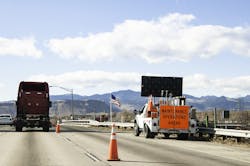Just like inspection and follow-up service are critical to maintaining commercial vehicle equipment, so it is for U.S. highways. And, in both instances, postponing that service can cost much more in the long run.
There is no more current applicable example to highlight the negative impact of deferred maintenance for infrastructure than that of the I-40 bridge closure in Memphis, Tennessee. The Hernando de Soto bridge was closed in mid-May when inspectors found a significant crack in a support beam that they determined could compromise the structural integrity of the bridge.
Along with the interstate being a main artery for commerce movement spanning between California and North Carolina, the bridge closure has impacted freight movement and caused major traffic delays. It spans the Mississippi River, connecting Arkansas to Tennessee. And Memphis is also the location of FedEx headquarters.
While the bridge is being repaired, some 50,000 vehicles that typically cross this bridge per day have been diverted. According to the Tennessee Department of Transportation, while delays are now only about 15 minutes, rerouted traffic initially created hour-long delays. The I-40 bridge closure and subsequent rerouting has cost the trucking industry an additional $70 million in unanticipated costs as of late June, according to the Arkansas Trucking Association. And as this issue goes to press, the TDOT confirmed the bridge will not reopen until at least August.
At the larger level, the country faces trillions of dollars in backlogged repairs, with more than 45,000 bridges throughout the U.S. in poor condition.
Thankfully, inspectors found the fracture on the I-40 bridge before any more significant damage had occurred.
The Champlain Towers South condominium collapse in mid-July is a more tragic recent example of delaying maintenance even though inspections indicated service was needed. The collapse, which has claimed nearly 100 lives, occurred despite the documentation of needed repairs three years prior to the collapse of the Miami-area condo. “A consultant found alarming evidence of ‘major structural damage’ to the concrete slab below the pool deck and ‘abundant’ cracking and crumbling of the columns, beams, and walls of the parking garage under the 13-story building,” noted a recent report from The New York Times.
While building inspections and preventive maintenance inspections aren’t exactly the same process, they both still recognize the importance of conducting the service as soon as is feasible after a problem is found.
Maintenance involves both the necessary regular inspections to catch defects early, as well as the on-time service and repair of these defects before they become major issues.
Takeaways for vehicle maintenance
Managing proper maintenance schedules to keep equipment operating is critical for two reasons: it reduces overall maintenance costs and improves safety.
An organization’s maintenance department aids in reducing operational costs by optimizing vehicle uptime. Through that logic, improved uptime translates to less money spent on larger and more severe repairs. Plus, when a vehicle isn’t down, it’s not sitting idle.
Improved vehicle uptime translates to reduced operational costs—whether that’s through less money that would otherwise be spent later to service or repair equipment, or the assurance that equipment is utilized and does not sit idle and unable to complete the job as intended.
All aspects of this industry are intertwined, and maintenance is one part of the entire web of a commercial fleet’s operation. While maintenance itself is an overhead cost that will not directly generate revenue, deferring that maintenance is a gamble. It can mean the difference between adding an exorbitant amount to operational expenses versus helping to improve a fleet’s bottom line.
As with all roles of each department within an organization, to reduce operational costs and improve safety requires vigilance and a focus on ensuring these two needs are constantly analyzed and met for respective businesses.
As someone who surely references this publication regularly (thank you, faithful reader), you are certainly aware of why it is critical that equipment be inspected regularly. What’s more, it is imperative that the results of those inspections are followed up with completing the necessary service and repairs.
About the Author
Erica Schueller
Media Relations Manager | Navistar
Erica Schueller is the Media Relations Manager for Navistar.
Before joining Navistar, Schueller served as Editorial Director of the Endeavor Commercial Vehicle Group. The commercial vehicle group includes the following brands: American Trucker, Bulk Transporter, Fleet Maintenance, FleetOwner, Refrigerated Transporter, and Trailer/Body Builders brands.
An award-winning journalist, Schueller has reported and written about the vehicle maintenance and repair industry her entire career. She has received accolades for her reporting and editing in the commercial and automotive vehicle fields by the Truck Writers of North America (TWNA), the International Automotive Media Competition (IAMC), the Folio: Eddie & Ozzie Awards and the American Society of Business Publication Editors (ASBPE) Azbee Awards.
Schueller has received recognition among her publishing industry peers as a recipient of the 2014 Folio Top Women in Media Rising Stars award, acknowledging her accomplishments of digital content management and assistance with improving the print and digital products in the Vehicle Repair Group. She was also named one Women in Trucking’s 2018 Top Women in Transportation to Watch.
She is an active member of a number of industry groups, including the American Trucking Associations' (ATA) Technology & Maintenance Council (TMC), the Auto Care Association's Young Auto Care Networking Group, GenNext, and Women in Trucking.
In December 2018, Schueller graduated at the top of her class from the Waukesha County Technical College's 10-week professional truck driving program, earning her Class A commercial driver's license (CDL).
She has worked in the vehicle repair and maintenance industry since 2008.

